 It’s been a hard year…I know I haven’t posted in a long time. I have simply not had the time or mental space to write or do genealogy. One of the biggest reasons is that my beloved Grandmother Olive passed away in December at the age of 101.
It’s been a hard year…I know I haven’t posted in a long time. I have simply not had the time or mental space to write or do genealogy. One of the biggest reasons is that my beloved Grandmother Olive passed away in December at the age of 101.
She had slowed down the last few years, but her mind was still tracking. I can’t tell you what a hole this left in the lives of our family…truly she was our matriarch.
I have never written about her in this blog because she was still living and for someone who hated modern technology and was extremely private, she would have hated anything being out in the media. Hopefully, she will forgive me posting about her now and know that it is done in love and remembrance. We miss her!
Eulogy January 4th, 2019
I asked my Grandmother in her early 90’s what she thought was the secret to her longevity. She said “Getting up, getting dressed and getting out of the house every day.” This sounds like simple advice, but it says a lot about her approach to life in general. Like most people, she had challenges throughout the years, but she powered through, she kept moving and touching the lives of those she held close.
Olive was born in Chicago, Illinois on October 25, 1917, and was named for her grandmothers Olive Dibben and Margaret Dey. She was proud of having her roots begin in that very American city of industry and grit. She often talked about both her parents working in the city that invented the department store. Before Olive was born, her mother Minnie was a bookkeeper for Hart, Schaftner and Marx, a men’s Haberdashery store. Her father Walter was a notions salesman for Carson, Pieri and Scott in their wholesale division before he opened his own store. But they didn’t stay in Chicago; Walter believed there was more opportunity in California and moved the family to Glendale in 1923 when Olive was 6 years old. Walter opened the First Street Store in Los Angeles in 1924. The “store” as it was called in our family played a huge part in Olive’s life.
Olive attended a private French elementary school in Glendale. Later in life she tried to teach all of us French to varying degrees of success. When she lived in Glendale she often visited her grandparents Margaret and Blanchard Dey who had also moved to California for Blanchard’s health. Grandpa Dey had been a pianist and piano tuner back in Chicago. She loved to listen to him play the piano and this began a lifelong love of music for her. In retirement, Grandpa Dey raised chickens which she thought of as her pets of course!
 In 1927, the family moved to South Pasadena where Olive attended Los Flores Elementary School. Her favorite uncle Harry lived with them and she often talked about Harry’s extensive collection of books. It was from Harry that she developed her interest in England (where he was born), history and literature. It was also when she got pets of her own: Roger, who was part Russian Wolf Hound, Peg a Scottish Terrier and canaries. She went to the Rialto Theater in Pasadena on Fair Oaks every Saturday for the matinee and sat in the balcony.
In 1927, the family moved to South Pasadena where Olive attended Los Flores Elementary School. Her favorite uncle Harry lived with them and she often talked about Harry’s extensive collection of books. It was from Harry that she developed her interest in England (where he was born), history and literature. It was also when she got pets of her own: Roger, who was part Russian Wolf Hound, Peg a Scottish Terrier and canaries. She went to the Rialto Theater in Pasadena on Fair Oaks every Saturday for the matinee and sat in the balcony.
Olive attended South Pasadena Junior High and High School and played field hockey, tennis, and volleyball. She sang in the Presbyterian Church choir and the school Glee Club. She was in the Peter Pan Players, the High School Drama Club and French Club. She hung out with a group of girls: Jenner Brohm, Sandy, Edith, Dolly, Eleanor and Virginia. Jenner’s father “Pop” drove the girls to all the high school football games, to the movies, shopping on Saturday and to the beach. Her friend, Chet Halsey took her to the senior prom. Sadly, he would later die in WWII.
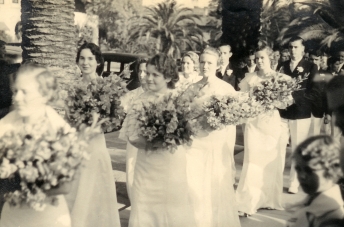 Olive graduated from South Pasadena High School in 1935. And that summer her parents rented a house on Balboa Island. She remembered this summer fondly because she met a young man named Bob Kemp who taught her to drive.
Olive graduated from South Pasadena High School in 1935. And that summer her parents rented a house on Balboa Island. She remembered this summer fondly because she met a young man named Bob Kemp who taught her to drive.
She attended Occidental College from 1935 to 1937 and studied music and literature, but her father thought she should have a practical education. Walter sent her to Bright McMann Business College from 1937-1938 where she learned typing, dictation, bookkeeping, shorthand and flower arranging. (I think this might be the reason she never really cared for getting flowers.) Olive remembered Mrs. McMahon as being strict and not very friendly. She insisted they took the 1st job they were offered whether they liked it or not. Olive took a job at the law office of Renwick and DeVoore and stayed for less than a year. She said they were cheap and made her work long hours! She quit and got a job working for the Southern California Gas Company.
In 1936, Olive’s friend from Occidental College, Hope Harper, invited her to go to Annapolis for June week to visit her brother. She often talked about all the brave wonderful men they met and danced with. They later went back to Annapolis in the fall of 1941 to see a friend from Chicago, Allan Gernhardt. But when Pearl Harbor was attacked on December 7th, his class graduated early in February of 1942. Allen was killed onboard the Smith in the Battle of the Coral Sea in October 1942. All the young men Olive met in her visits to Annapolis served in WWII and quite a few died during the war. It was a highly emotional time with men going off to war and romances happened quickly. In 1942, Olive was visiting her aunt and uncle in Riverside and while there she met Arthur Cork at the Mission Inn. He was stationed at March Airfield in Riverside before he was shipped out to the Pacific Theater. They got married on May 16, 1942, and on March 6, 1943, their daughter Diana Lee was born. But this marriage was not meant to be and they divorced soon after.
 Like many women during WWII, Olive wrote to her friends who were serving in the military to keep up their spirits while away from home. She renewed her friendship with Bob Kemp who was a family friend from the Balboa summers and sent him letters when he was stationed in Hawaii, Guam and Tiapan. Through their letters, they fell in love and when Bob came home in 1946, they married on February 20th. They soon had their son Bob and a few years later their daughter Ruth.
Like many women during WWII, Olive wrote to her friends who were serving in the military to keep up their spirits while away from home. She renewed her friendship with Bob Kemp who was a family friend from the Balboa summers and sent him letters when he was stationed in Hawaii, Guam and Tiapan. Through their letters, they fell in love and when Bob came home in 1946, they married on February 20th. They soon had their son Bob and a few years later their daughter Ruth.
 Bob went to work at First Street Store working as a manager and eventually taking over the running of the store when Walter retired. Olive raised their three children until they all graduated from school. With time on her hands, she was finally free to explore her passion for animals and became a docent for the Los Angeles Zoo for 20 years. She led school groups for a few years but her favorite job was working in the nursery with the primates. She loved the baby gorillas, orangutans and chimpanzees. When you wanted to see pure joy on Olive’s face you have only to look at her holding a primate baby (which includes humans.) She loved babies! She would sing them French lullaby’s, play patty cake, teach them sign language and rock them asleep. When she finally retired from the zoo, she continued to support rescue groups for horses, pigs, dogs, cats, wolves etc. There wasn’t an animal she didn’t love.
Bob went to work at First Street Store working as a manager and eventually taking over the running of the store when Walter retired. Olive raised their three children until they all graduated from school. With time on her hands, she was finally free to explore her passion for animals and became a docent for the Los Angeles Zoo for 20 years. She led school groups for a few years but her favorite job was working in the nursery with the primates. She loved the baby gorillas, orangutans and chimpanzees. When you wanted to see pure joy on Olive’s face you have only to look at her holding a primate baby (which includes humans.) She loved babies! She would sing them French lullaby’s, play patty cake, teach them sign language and rock them asleep. When she finally retired from the zoo, she continued to support rescue groups for horses, pigs, dogs, cats, wolves etc. There wasn’t an animal she didn’t love.
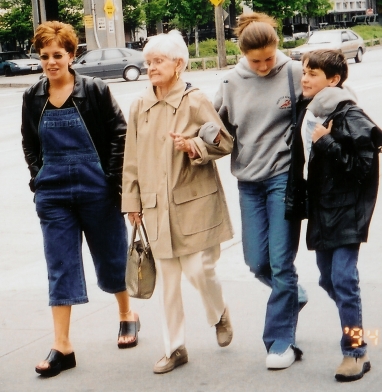 She and Bob traveled a lot in retirement. They reached a compromise in going to places that he could golf, and she could see historical sights or animals. They took cruises and went to Europe, Africa and Australia. They also regularly visited their grandchildren, me and my family in Seattle and Raquelle in Arizona.
She and Bob traveled a lot in retirement. They reached a compromise in going to places that he could golf, and she could see historical sights or animals. They took cruises and went to Europe, Africa and Australia. They also regularly visited their grandchildren, me and my family in Seattle and Raquelle in Arizona.
When Bob died in 1992, she continued to travel to see family or to travel with family. She was taking trips to Seattle for 2 weeks visits up until she was 96!
A few years after Bob died, the store went through a financial crisis caused by unethical management. Olive at 80 years old, made the decision to step in and take a hands-on role in the business. With the help of Martha and other longtime loyal First Street employees, they kept the business going. Grandma was determined to explore every avenue to turn things around and she enjoyed working with the women of First Street. It took a long time before she could accept that the store’s life had run its course and couldn’t compete with big chains like Target and Walmart. She reluctantly made the decision to sell in 2007.
Olive Margaret Dibben Kemp touched the lives of many people in the 101 years she was here on this earth. We all knew her a little differently and called her different names: Olive, Grandmere, Oma and GGO, but we are united in our love for this wonderful woman. She understood the power of relationships, and I just need to look at all of you who are here today, to know that she touched all of you.
 Both my sister Raquelle and I saw her as the mother figure who swooped in and rescued us from a turbulent childhood. She picked me up from school, took me to doctor’s appointments and bought school clothes for me. But what she really did was taught me to have a love for learning. My best memories of childhood are of Grandma taking me to Vroman’s and letting me get as many books as I wanted. She never told me no about the number of books I could have or the type of book I could read. My mother told me that when I was five, I told her I was going to college. I don’t have a memory of that, but it never occurred to me to do anything else and that was because of Grandma. She believed in the power of education and supported all of us to attend financially and emotionally.
Both my sister Raquelle and I saw her as the mother figure who swooped in and rescued us from a turbulent childhood. She picked me up from school, took me to doctor’s appointments and bought school clothes for me. But what she really did was taught me to have a love for learning. My best memories of childhood are of Grandma taking me to Vroman’s and letting me get as many books as I wanted. She never told me no about the number of books I could have or the type of book I could read. My mother told me that when I was five, I told her I was going to college. I don’t have a memory of that, but it never occurred to me to do anything else and that was because of Grandma. She believed in the power of education and supported all of us to attend financially and emotionally.
Raquelle and I were talking about how much our memories of Grandma are rooted in this area (Pasadena). We cannot drive by a location without thinking of the time we spent here with Grandma. She took us everywhere including the Huntington Library, the Atheneum, the Norton Simon, Green Street Café, Twooey’s, the pharmacy where she met Karma, Margie’s shop, the post office, Bullock’s and Robinsons (now Macy’s and Target…quel dommage!), Church of our Savior and later St. Edmunds. Through her errands and field trips, she taught us about culture, friendship and community.
We also have our family stories of the things we would say to each other. When we toasted she would say “here is looking up your kilt!” Or when we were taking her back to her hotel on a visit, she never wanted to be any trouble so she would say just drop her off in front….and it got to be a joke between us all “tuck and roll grandma, tuck and roll!”
 Olive was insightful, witty, wryly observant and at times had a wicked sense of humor. She also liked to gossip and dish. She knew who had the inside scoop to what was going on and she would find you!
Olive was insightful, witty, wryly observant and at times had a wicked sense of humor. She also liked to gossip and dish. She knew who had the inside scoop to what was going on and she would find you!
She had a wonderful sense of style and seemed to get more adventurous and dress in brighter colors the older she got. We often told her that we would gratefully accept any of her hand me downs when she was ready to part with them.
And Olive could be stubborn. The quintessential reminder of this for me is her clothesline. It is 2018 and she never had a clothes dryer. She continued to hang her clothes on a clothesline until well into her 90’s because she didn’t like the way clothes felt from a dryer. She was fiercely independent, and she was 95 before she would ask anyone for help. Grandma knew her own mind and what she wanted and I think all her descendants have inherited that trait. And we are all proud of that…whether through example or genes she gave us all grit, determination and stubbornness.
 She was also so generous – to her family, friends, to church, and of course her animal causes. We have all been the recipients of her altruism. She was somewhat of an enigma. I have spent my life trying to figure out what made her tick…what motivated her. I know she loved deeply, but she was a product of older reserved parents and it wasn’t in her nature to reflect on her choices. I know she had regrets and disappointments like all of us.
She was also so generous – to her family, friends, to church, and of course her animal causes. We have all been the recipients of her altruism. She was somewhat of an enigma. I have spent my life trying to figure out what made her tick…what motivated her. I know she loved deeply, but she was a product of older reserved parents and it wasn’t in her nature to reflect on her choices. I know she had regrets and disappointments like all of us.
She was a woman of her times – when one got married, had children, and supported your husband’s success. The problem was she really didn’t like to cook or clean house. In a different time, she might have picked a different life. But she knew how to make the best of the choices she had and created a lasting legacy.
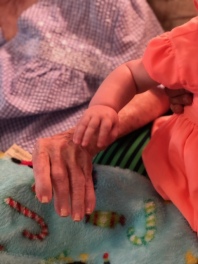 She was our matriarch and no one deserves the title more. I miss her and I know you miss her too. I want to keep telling stories about her so that I can still have some new insight into her mind and heart.
She was our matriarch and no one deserves the title more. I miss her and I know you miss her too. I want to keep telling stories about her so that I can still have some new insight into her mind and heart.
Please come up and tell us a story about Olive and how she touched you. Because that is what she would want – to know she made a difference in your life.
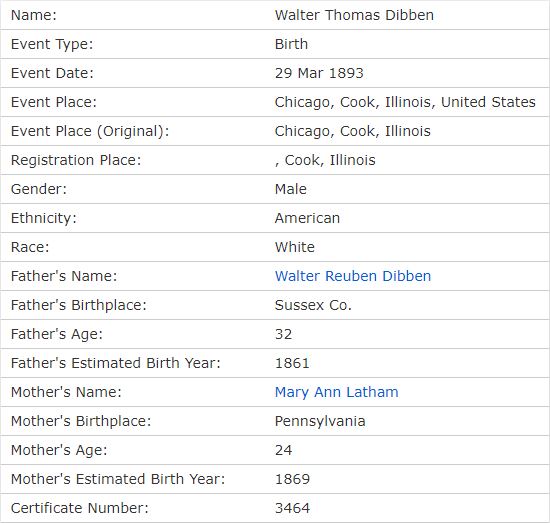







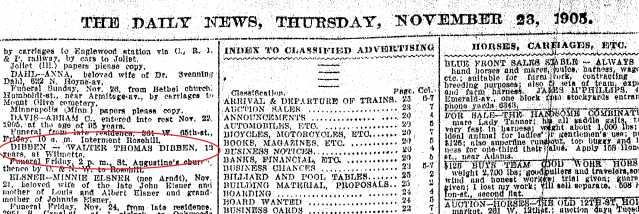

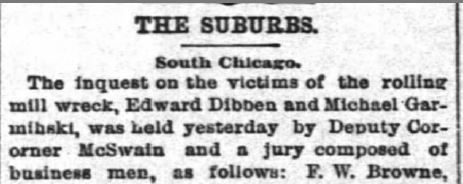
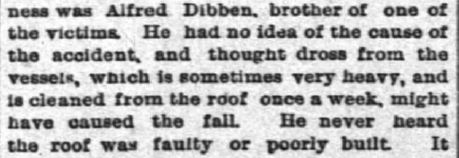






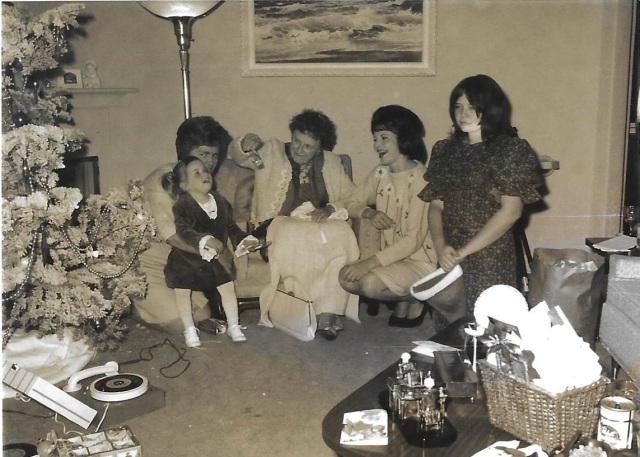




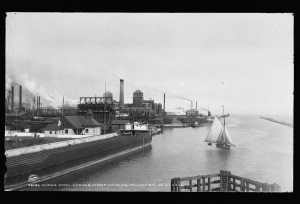
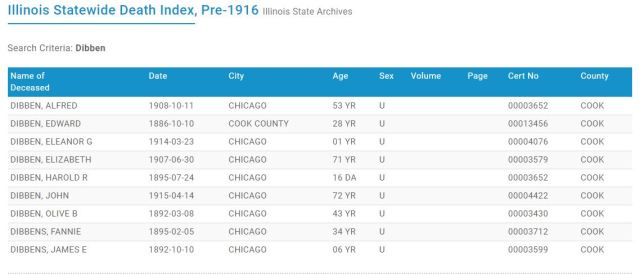




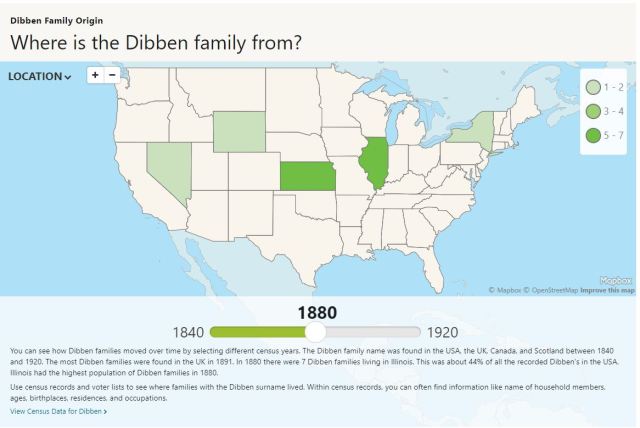







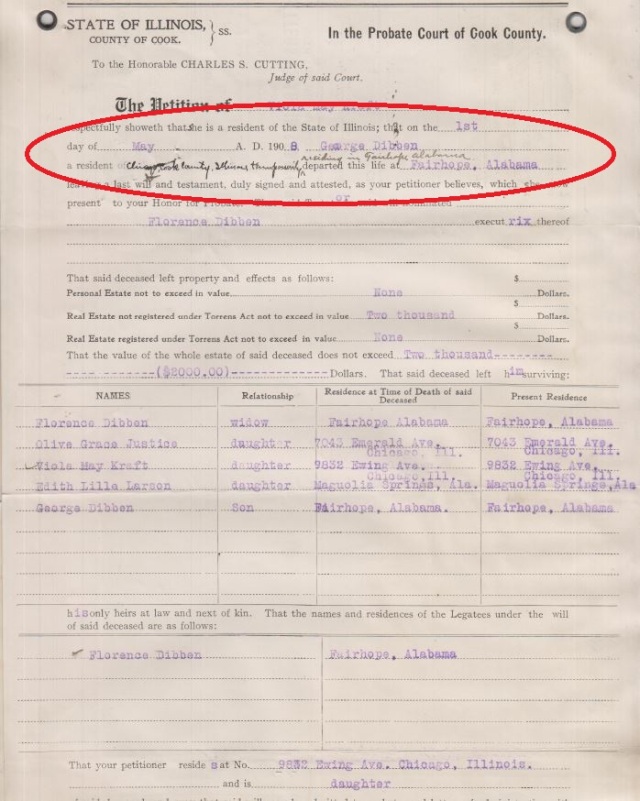
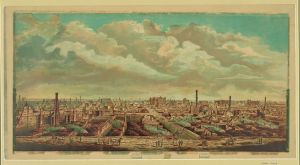
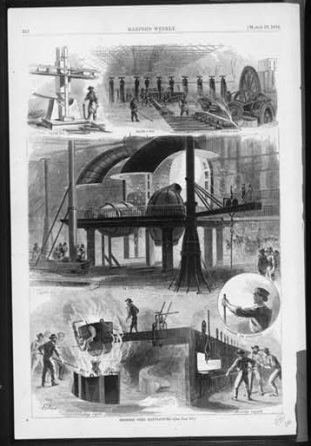






 It’s been a hard year…I know I haven’t posted in a long time. I have simply not had the time or mental space to write or do genealogy. One of the biggest reasons is that my beloved Grandmother Olive passed away in December at the age of 101.
It’s been a hard year…I know I haven’t posted in a long time. I have simply not had the time or mental space to write or do genealogy. One of the biggest reasons is that my beloved Grandmother Olive passed away in December at the age of 101. In 1927, the family moved to South Pasadena where Olive attended Los Flores Elementary School. Her favorite uncle Harry lived with them and she often talked about Harry’s extensive collection of books. It was from Harry that she developed her interest in England (where he was born), history and literature. It was also when she got pets of her own: Roger, who was part Russian Wolf Hound, Peg a Scottish Terrier and canaries. She went to the Rialto Theater in Pasadena on Fair Oaks every Saturday for the matinee and sat in the balcony.
In 1927, the family moved to South Pasadena where Olive attended Los Flores Elementary School. Her favorite uncle Harry lived with them and she often talked about Harry’s extensive collection of books. It was from Harry that she developed her interest in England (where he was born), history and literature. It was also when she got pets of her own: Roger, who was part Russian Wolf Hound, Peg a Scottish Terrier and canaries. She went to the Rialto Theater in Pasadena on Fair Oaks every Saturday for the matinee and sat in the balcony. Olive graduated from South Pasadena High School in 1935. And that summer her parents rented a house on Balboa Island. She remembered this summer fondly because she met a young man named Bob Kemp who taught her to drive.
Olive graduated from South Pasadena High School in 1935. And that summer her parents rented a house on Balboa Island. She remembered this summer fondly because she met a young man named Bob Kemp who taught her to drive. Like many women during WWII, Olive wrote to her friends who were serving in the military to keep up their spirits while away from home. She renewed her friendship with Bob Kemp who was a family friend from the Balboa summers and sent him letters when he was stationed in Hawaii, Guam and Tiapan. Through their letters, they fell in love and when Bob came home in 1946, they married on February 20th. They soon had their son Bob and a few years later their daughter Ruth.
Like many women during WWII, Olive wrote to her friends who were serving in the military to keep up their spirits while away from home. She renewed her friendship with Bob Kemp who was a family friend from the Balboa summers and sent him letters when he was stationed in Hawaii, Guam and Tiapan. Through their letters, they fell in love and when Bob came home in 1946, they married on February 20th. They soon had their son Bob and a few years later their daughter Ruth. Bob went to work at First Street Store working as a manager and eventually taking over the running of the store when Walter retired. Olive raised their three children until they all graduated from school. With time on her hands, she was finally free to explore her passion for animals and became a docent for the Los Angeles Zoo for 20 years. She led school groups for a fe
Bob went to work at First Street Store working as a manager and eventually taking over the running of the store when Walter retired. Olive raised their three children until they all graduated from school. With time on her hands, she was finally free to explore her passion for animals and became a docent for the Los Angeles Zoo for 20 years. She led school groups for a fe She and Bob traveled a lot in retirement. They reached a compromise in going to places that he could golf, and she could see historical sights or animals. They took cruises and went to Europe, Africa and Australia. They also regularly visited their grandchildren, me and my family in Seattle and Raquelle in Arizona.
She and Bob traveled a lot in retirement. They reached a compromise in going to places that he could golf, and she could see historical sights or animals. They took cruises and went to Europe, Africa and Australia. They also regularly visited their grandchildren, me and my family in Seattle and Raquelle in Arizona. Both my sister Raquelle and I saw her as the mother figure who swooped in and rescued us from a turbulent childhood. She picked me up from school, took me to doctor’s appointments and bought school clothes for me. But what she really did was taught me to have a love for learning. My best memories of childhood are of Grandma taking me to Vroman’s and letting me get as many books as I wanted. She never told me no about the number of books I could have or the type of book I could read. My mother told me that when I was five, I told her I was going to college. I don’t have a memory of that, but it never occurred to me to do anything else and that was because of Grandma. She believed in the power of education and supported all of us to attend financially and emotionally.
Both my sister Raquelle and I saw her as the mother figure who swooped in and rescued us from a turbulent childhood. She picked me up from school, took me to doctor’s appointments and bought school clothes for me. But what she really did was taught me to have a love for learning. My best memories of childhood are of Grandma taking me to Vroman’s and letting me get as many books as I wanted. She never told me no about the number of books I could have or the type of book I could read. My mother told me that when I was five, I told her I was going to college. I don’t have a memory of that, but it never occurred to me to do anything else and that was because of Grandma. She believed in the power of education and supported all of us to attend financially and emotionally. Olive was insightful, witty, wryly observant and at times had a wicked sens
Olive was insightful, witty, wryly observant and at times had a wicked sens She was also so generous – to her family, friends, to church, and of course her animal causes. We have all been the recipients of her altruism. She was somewhat of an enigma. I have spent my life trying to figure out what made her tick…what motivated her. I know she loved deeply, but she was a product of older reserved parents and it wasn’t in her nature to reflect on her choices. I know she had regrets and disappointments like all of us.
She was also so generous – to her family, friends, to church, and of course her animal causes. We have all been the recipients of her altruism. She was somewhat of an enigma. I have spent my life trying to figure out what made her tick…what motivated her. I know she loved deeply, but she was a product of older reserved parents and it wasn’t in her nature to reflect on her choices. I know she had regrets and disappointments like all of us. She was our matriarch and no one deserves the title more. I miss her and I know you miss her too. I want to keep telling stories about her so that I can still have some new insight into her mind and heart.
She was our matriarch and no one deserves the title more. I miss her and I know you miss her too. I want to keep telling stories about her so that I can still have some new insight into her mind and heart.

